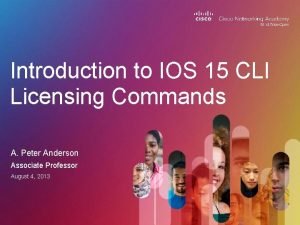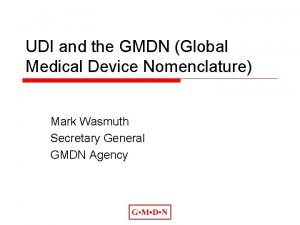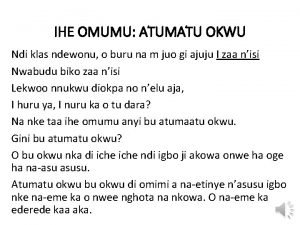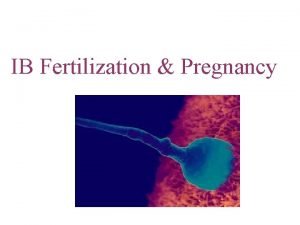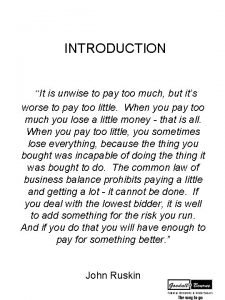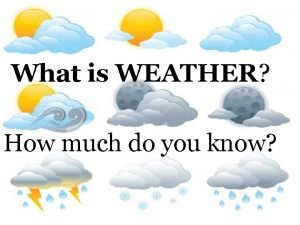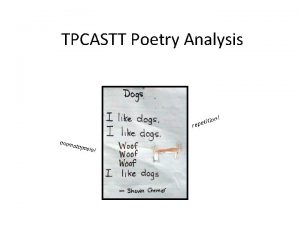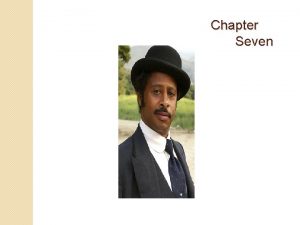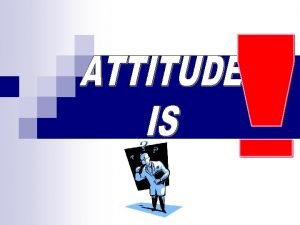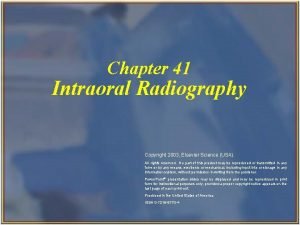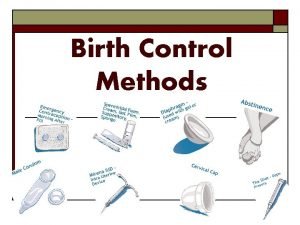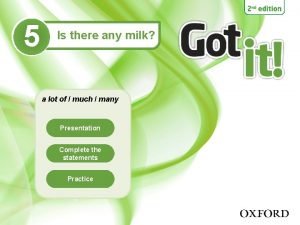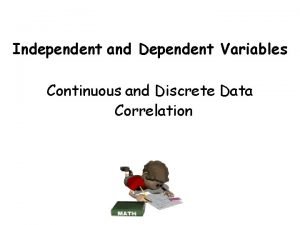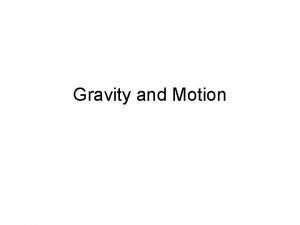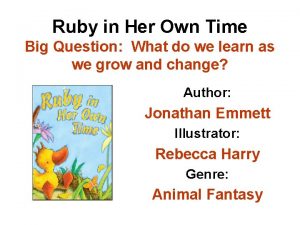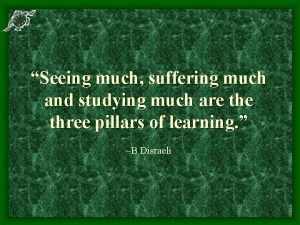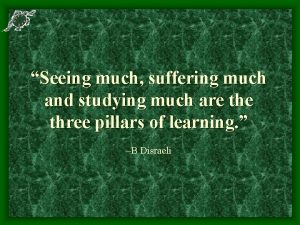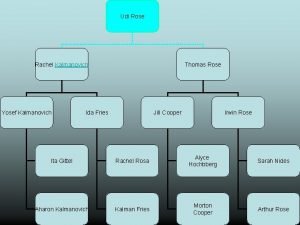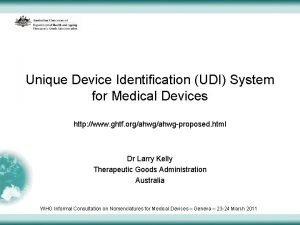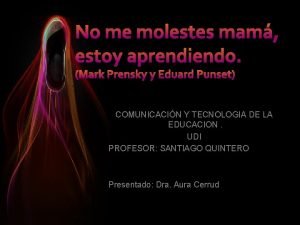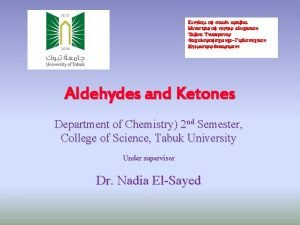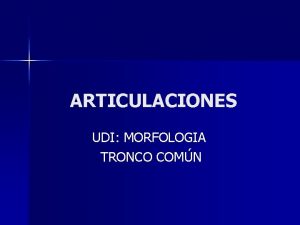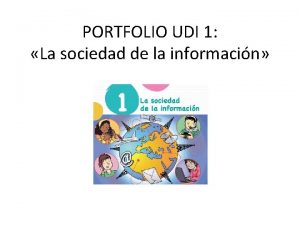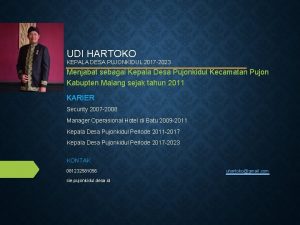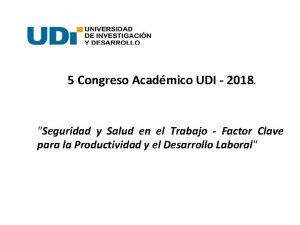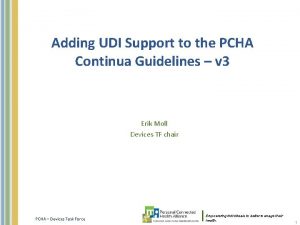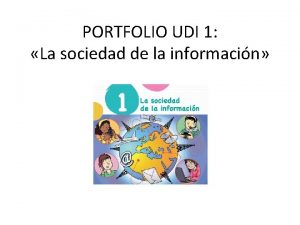How much Udi is Udi Or What do





































- Slides: 37

How much Udi is Udi? Or: What do we describe when we describe a language? 1 2. PRACOVNÉ STRETNUTIE VEDECKOVÝSKUMNÉHO TÍMU CENTRA PRE JAZYK A JAZYKOVÚ PRAX WOLFGANG SCHULZE 14. 06. 2016 05. 03. 2021

Basic Question 2 What is ‚a language‘? Scientific view External view Internal view 05. 03. 2021

Basic Question 3 Is language a „structural‘ phenomenon? Or: Is ‚language‘ the total of the linguistic practices of a social group? => ‚System Linguistics‘ vs. ‚Sociolinguistics‘ 05. 03. 2021

Ethnicity 4 How to define Ethnicity? Group-internal view: Social unit, that construes and maintains a collective identity based on a bundle of distinctive features present in the traditional and conventionalized sociocultural knowledge patterns of the community. - Each group defines the relevance of the corresponding features differently. The way people do this is again part of the cultural knowledge of the community. 05. 03. 2021

Ethnicity 5 Prototypical: - Collective knowledge: Conventionalized knoweldge about social, cultural, and economic practices and about the ‚interpretation of the world‘. - History: Genealogical identity. - Regionality: Attribution of a regional (also mythological) homeland to the given community. - Institutionalization: ‚Administration‘ of traditional knowledge by a specific group within the community 05. 03. 2021

Ethnicity 6 External view: Construction of ‚experiences of difference‘ by a commnunity with regard to other communities. => Stereotyping und classification of ‚otherness‘ with the help of the community‘s patterns of ethnicity. => Identification of other rulerships as entailing a different ‚ethnic‘ pattern. 05. 03. 2021

Language 7 Internal view: - Social knowledge: Language as a part of social interactional patterns (communication). - - But: Language is not a necessary part of construing ‚ethnicity‘! But: Language may support the stabilization of ethnicity constructions. This does not necessarily mean that an ethnic group should be marked for one language (cf. multilingual ethnic groups). 05. 03. 2021

Language 8 Language and Power: “a shprakh iz a dialekt mit an armey un flot. “ ‚A language is a dialect with an army and a navy‘) (Weinreich 1945: 13) 05. 03. 2021

Language 9 External view: Societies may (!) related to experiecne of differences in communicative practices as being part of a bundle of ethnic markers. But: This is not a ‚must‘! - It happens especially if the given society sees itss own system of linguistic practices as constituing a relevant part of their ethnicity. 05. 03. 2021

Getting started 10 1. Language does not exist ‚by itself‘, but only in terms of socially controlled linguistic practices grounded in a more or less collective knowledge system. 2. Documenting a language means to document linguistic practices as they are (and not as they should be). 3. ‘Languages’ are usually endangered because speakers have the option to profile their linguistic practices with respect to ‘another’ linguistic knowledge system acquired more or less in parallel during the process of language acquisition. 4. Hence, the question is how to delimit the ‘languages’ involved in observed linguistic practices. 05. 03. 2021

Udi (1) 11 Udi: Spoken/known by roughly 8. 000 people - Village of Nij in Northern Azerbaijan (3. 000) - Village of Oguz (Vartashen) in Northern Azerbaijan (50 ? ) - Village of Oktomberi/Zinobiani (since 1922) in Eastern Georgia (150) - Diaspora in Russia, Armenia, Kazakhstan etc. (3. 500) 05. 03. 2021

Udi (1) 12 Udi: Traditionally defined as an East Caucasian language belonging to the Southeast Caucasian (Lezgian) group: Tsezic 05. 03. 2021

Udi (1) 13 Two dialects: - Vartashen (Oguz, Oktomberi (sub-variety), Diaspora) - Nij (Nij, Diaspora) Udi: ‚Niece‘ (or ‚daughter‘ ? ) of Caucasian Albanian: 05. 03. 2021

Udi (1) 14 Language contact (as far as data go!): 500 BCE – 700 CE: Strong contact with older Northwest Iranian varieties (Medic, Parthian etc. ) 400 CE – 700 CE: Strong impact from Old Armenian, accompanied by impact from Old Georgian 700 CE – 1990: Stabilized contact with local Middle East and Modern East Armenian varieties, local Iranian varieties (esp. Tati in the Vartashen region) 700 CE: Beginning ‚Orientalization‘ of Udi (Arabic, early Azerbaijani varieties, Persian); massive Azertification 1850 – 1990: Partial intrusion of Russian 1990 till now: Ongoing Azerification, ‚De-Armenzation‘ of Udi 05. 03. 2021

Observation 15 Udi (Nij) däniz-ä gele ost’ahar tufan-e sea-LOC much strong storm-3 SG ’There comes up a strong storm on the sea. ’ (Jona 1. 4) (Translation by translator group in Nij 2009) Azeri: dǝnizde böyük bir fırtına qopdu bak-sa become-PRES Loans: däniz (Azeri), gele (NW-Iranian), ost’ahar (Persian), tufan (Turkic) Native: bak(-sun) Question: Which language is present in this phrase? Udi? Azeri? Mixed language? What is endangered in Udi? 05. 03. 2021

Caucasian Albanian 16 A (re-? )discovered forerunner of Udi �CAUCAUSIAN ALBANIAN Re-implemented in Udi society by Udi intelligentsia (following official programmatics) as being part of the Udi cultural traditions. 05. 03. 2021

Caucasian Albanian 17 Religious and (seemingly) ‚official‘ language in the kingdom of Caucasian Albania (100 BCE – 705 CE), christianized in the 4 th-5 th century). Script: Proper script (part of the Transcaucasian Mashtots-script tradition) Sample: Documents: a) Seven very short inscriptions b) ‚Caucasian Albanian Palimpsests‘ (found in the Catharine monastary, Sinai in 2000, identified as ‚Caucasian Albanian‘ by Zaza Aleksidze, deciphered and edited by Jost Gippert and Wolfgang Schulze (2003 -2009). 05. 03. 2021

Caucasian Albanian 18 The Mingechaur pedestal (558 CE ? ) [Gippert, Schulze et al. 2009, I: II, 86] 05. 03. 2021

Caucasian Albanian 19 Sample of Palimpsest (Lk 4, 29 -36) [Gippert, Schulze et at. 2009, II: VI, 38 -39] 05. 03. 2021

Udi (2) 20 Some cultural features: L 1 -aquisition: Traditional bilingualism/multilingualism Religion: Christian (unclear affiliation; historically monophysite, strong dyophysite tendencies in Varatshen since 1820); grwoing impact from Russian Orthodoxy since 1989. Economics: No specific profile farming, cattle breeding, rice cultivation, sericulture, horticulture, poultry farming, craftsmanship and viticulture) Feasts and rites: Christian patterns strongly accommodated to Islamic environment (e. g. komrad festival => Qurban, žoğulun axc´ibay => Novruz) Kinship structure: Traditional Oriential Food and Dishes: Locally elaborated „Oriental“ (note: allowance of pig meat) Marriage patterns: Historically (1820 -1989) intermarriage between Nij and Vartashen Udis was stigmatized (as well as between Udis and Armenians in Vartashen) Linguistic Camouflage: E. g. greeting as-salâm caleykum etc. instead of (older) xeyrq´anbake ‚you will/shall be blessed‘ Naming (surnames): Historically often Armenian (e. g. Lukasyan) or Russian (e. g. Bežanov), now Azeri (Lukasoğlu), Georgian in Oktomeri (Džejranišvili) Naming of Nij quarters: Azeri (Hajibayli, Darabag, Daramahla, Vazirli, Farimli, Malbel, Agdamekli, Melikli, Falshyly, Manjyly, Delekli, Chirmakhli, Abdally) Traditional music: Azerbaijani styled Modern writings (based on Azeri orthography): Mostly translations from Azeri, some folk tales. 05. 03. 2021

Udi (2) 21 Traditional Sociolinguistics: Cilfton et al. 2005: Older generation: Bilingual Udi-Russian, in parts + Azeri) Younger generation: Biliangual Udi-Azeri (in parts + Russian) „It is clear that all age groups actively use Udi in a wide range of settings. In that sense it has high vitality. Udi people have the opportunity to learn other languages and are at least functionally bilingual in Russian and Azerbaijani. Furthermore, adults feel it is important for their children to learn both Russian and Azerbaijani. In spite of this, they want their children to be well grounded in Udi and speak only Udi at home. The Udi people are very proud of their language and have no intention of giving it up. “ (sic!) 05. 03. 2021

Udi (2) 22 But: (a) Due to the emigration of Armenians from Vartashen, no reference is made by Clifton et al. (2005) toward the (former) role of Armenian (esp. in Vartashen). (b) Clifton et al. do not discuss the question, what is understood by „Udi“ by their informants. Sample of Udi (a) Udi (Nij) (b) Udi (Oktomberi) (c) Udi song (modern) (d) Lord‘s prayer in modernized presentation 05. 03. 2021

Udi (2) 23 OBSERVATION „Give me (some) bread!“ Udi (U): Azeri (A): MEA (M): za mǝnǝ inj I. DAT śum çörek hacc bread tada ver tur give. IMP Observed spontaneous mixture in Vartashen (Oguz) (1985) za çörek tada za hacc tada mǝnǝ śum tada za śum ver za hacc ver za çörek ver za śum tur za çörek tur za hacc tur U+A+U U+M+U A+U+U U+U+A U+M+A U+A+A U+U+M U+A+M U+M+M 05. 03. 2021

Udi (2) 24 Usage-based frequency of phonemes (Udi/Azeri) 05. 03. 2021

Udi (2) 25 Lexicon: Udi dictionaries Gukasjan 1 1974 Mobili 2010 73, 7 % 62, 4 % 26, 3 % 37, 6 % (Non-Azeri incl. loans from Armenian, Russian etc. ) Azeri/Oriental Loans cover all domains over everday life and cannot be related to specific conceptual domains or domains of cultural/social practices. 05. 03. 2021

Udi (2) 26 Morphology: Derivation mainly based on Azeri morphemes Else: Significant formal differences, but structural affinities, confer: Udi: (bez) I. POSS xaʕ dog Azeri mən-im it-im I-1. SG. POSS dog-1 SG. POSS ‚I don‘t have a dog. ‘ Udi: meyvan-a fruit-O. DEF uk‘-i-zu eat-PAST-1 SG Azeri meyvən-i fruit-O. DEF ‚I ate the fruit. ‘ ye-di-m eat-PAST-1 SG te-zax-p´u NEG-I. DAT-COP. PRES yox-dur be=not-COP. PRES „water-without“ (‚waterless‘) xe-nut‘ (U+U) xe-suz (U+A) su-nut‘ (A + U) su-suz (A + A) 05. 03. 2021

Udi (2) 27 Question: What is ‚Udi‘ for a speaker of Udi? Problem: S 1: venk´ ek´a-a udi-n muz? you. SG. BEN what-3 SG. Q Udi-GEN language ‚What is the Udi language for you? ‘ S 2: t´e DIST muz-e ma-t‘-in-te language-3 SG which-SA-ERG-SUB yoldaš-muǧ-oxol ixt´ilät-zu-b-sa friend-PL-COM conversation-1 SG-do-PRES ‚That language I use when talking to friends. ‘ 05. 03. 2021

Udi (2) 28 Hence: Is Udi a „variety according to use“ (‚stylistic variant’) / Functional native bilingualism / rather than a „variety according to user“ (in terms of first language acquisition) (cf. Halliday/Mc. Intosh/Strevens 1994: 87) ? ? ? Cf. : mot´ǧoxol metär ixt´ilätzubsa, šot´ğoxol t´etär. ‚With these, I speak this way, with those, I speak that way. ‘ (Vartashen 1985) 05. 03. 2021

Udi (2) 29 Question: ek´enu čalxsa te vi yoldašen udin muzin ixt´ilätt´ebsa? ‚How to you know that your friend speaks Udi? ‘ Answer: teza avabaksa. . ‚I don‘t know. . . ‘ 05. 03. 2021

Udi (2) 30 Hence: How do naive speakers define their language: Grammar or Lexicon or Phonetics/Phonology? Udi: Azeri: bütün ğarmuğo kağizzu campsa bütün oğlanlara məktub yazıram. ‚I write a letter to all the boys. ‘ OK: bütun oğlan-ğ-o mäktub yazmiš-zu-b-sa (Azeri lexicon, Udi grammar) Not OK: *bitum ğar-lar-a kağiz cam-p-ir-am (‚Udi‘ lexicon, Azeri grammar) 05. 03. 2021

Udi (2) 31 Sociology of knowledge: Karl Mannheim (1893 -1947) Communicative knowledge: explicit and reflective knowledge (‚knowing/talking ‚about‘, cf. Roland Barthes) => Most of lexicon/idioms etc. , in parts phonetics. Conjunctive knowledge: implicit, experiential knowledge grounded in everyday practices , nonreflective, praxeological (Barthes) (‚common sense’ > Habitus (Pierre Bourdieu)) => Most of grammar (but not derivation!) 05. 03. 2021

Udi (2) 32 Internal view (of speech community) on language: Communicative knowledge: A language is perceived as being ‚specific‘ when experiencing (and reflecting) marked differences esp. in the lexicon and in phonetics (not: phonology!) The same holds for the external view (of other speech communities) => People identify a language due to the ‚otherness‘ of lexical and phonetic elements. Conjunctive knowledge (=> Grammar) does not play a (relevant) role in identifying a particular language from on internal/external view. 05. 03. 2021

Udi (2) 33 Given the fact that - the Udi lexicon is massively Azeri-shaped (=> communicative, explicit knowledge) and - the Udi grammar is (more or less) distinct from that of Azeri (=> conjunctive, implicit knowledge) we can ask: Does the Udi speaker perceive the ‚Udiness‘ of Udi only in terms of lexical/idiomatic peculiarities? 05. 03. 2021

Udi (2) 34 What would then (according to the communicative knowledge of Udi speakers) be the difference from a lexically/idiomatically marked variety of their Azeri practices? Confer: Jenish (German-based special language, here Swiss variant) selber I=myself linst-ne look=at-it ne it z-gwand to-intact z-menge to-do German: Ich schaute es (mir) an um es (wieder) ganz zu machen 05. 03. 2021

Udi (2) 35 So: What is endangered in Udi? Features: - Loss of non-Azeri lexical units when using the ‚Udi style‘? (Better: ongoing process of replacing non-Azeri lexical units by Azeri terms) But: What are ‚native‘ terms in Udi? What about older loans (e. g. Iranian, Armenian)? Are they ‚Udi‘? - Loss of conjunctive knowledge of Udi grammar. But: The grammar of Udi has resulted from very many patterns of language contact. What would then be ‚Udi‘ in the grammar of Udi? - Ongoing assimilation to articulatory traditions of Azeri. 05. 03. 2021

Udi (2) 36 Language awareness: The idea that Udi has a surplus for the speech community has been implemented in the community especially after 1989: - The Udi language as a testimony of the Albanian heritage in Azerbaijan. - Adaptation of European models of language as a parameter of (national or sub-national) identity. - Turning conjunctive (praxeological) knowledge into communicative knowledge ‚about Udi‘. - Implementation of the idea of Udi as being a genuine part, testimony, and ‚storehouse‘ (Herder) of ‚Udi culture‘. - Promoted by Udi intellectuals trained in big cities => Institutionalization of ‚Udihood‘ 05. 03. 2021

Udi (2) 37 Conclusion: From a praxeological point of view, Udi is on its way of turning into a marked local communicative style that will be used as long as it has corresponding social funtions (variety in usage). There are no ‚cultural‘ terms that cannot be translated into Azeri ‚Loss‘ of Udi (better: ongoing Azerfication of Udi) does not implicate a relevant ‚loss of cultural traditions‘ Only problem: Which language to be used in church services? Maybe that we assume as ‚Udi‘ will only survive as a newly shaped religious language (if ever popes will be trained on the basis of Udi) 05. 03. 2021
 How much
How much To whom much is given much is required meaning
To whom much is given much is required meaning How much is too much plagiarism
How much is too much plagiarism Show license udi
Show license udi Gmdn code database
Gmdn code database Arc 308
Arc 308 Udi apsel
Udi apsel W 3 schools python
W 3 schools python Udi interface
Udi interface Omumaatu myiri
Omumaatu myiri 78 fr 58786
78 fr 58786 Amniotic fluid index
Amniotic fluid index How much can industry
How much can industry It is unwise to pay too much
It is unwise to pay too much What kind of cloud is this
What kind of cloud is this Luke 12:48
Luke 12:48 How much did wanda pay in taxes this pay period?
How much did wanda pay in taxes this pay period? Tpcast poetry
Tpcast poetry How much do panthers weigh
How much do panthers weigh How does jody react to this insult?
How does jody react to this insult? Red bull advertising budget
Red bull advertising budget Comic relief in romeo and juliet
Comic relief in romeo and juliet Attitude iceberg
Attitude iceberg Symbolism in the world is too much with us
Symbolism in the world is too much with us Much do you need health
Much do you need health How much do you already know about
How much do you already know about Chapter 41 intraoral imaging
Chapter 41 intraoral imaging Gather thee rosebuds while ye may
Gather thee rosebuds while ye may How much does abstinence cost
How much does abstinence cost If a laboratory fire erupts, immediately
If a laboratory fire erupts, immediately There is a lot of milk
There is a lot of milk Independent variable vs dependent variable
Independent variable vs dependent variable How much fibre a day
How much fibre a day Cheese much or many
Cheese much or many How long is four score and seven years?
How long is four score and seven years? How much is the force of gravity
How much is the force of gravity Security is always too much until the day it is not enough
Security is always too much until the day it is not enough How much is a ruby
How much is a ruby



